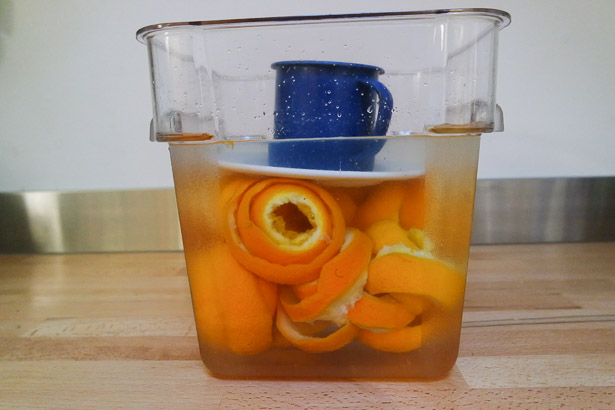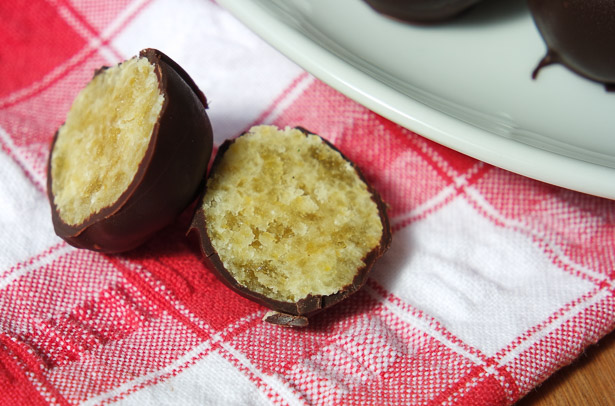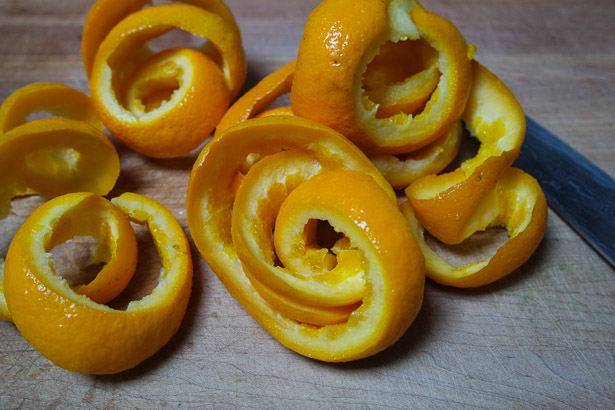First off, promise me that if you live near me, and your kids are in the twins’ class at school, you won’t make these for a teacher’s gift at Christmas, although I wouldn’t blame you if you did. This is a true something out of nothing dish, a stone soup of candy, if you will, and it is the perfect budget present, one that definitely does not announce that we are living in times of austerity, and one that can accommodate anyone’s Christmas budget. So I’m bagsy-ing it for a teacher’s Christmas gift.
Now that we’ve settled that, perhaps we can talk about why I appear to have a penchant for making things, particularly orange things, in a ball shape. I blame it on Giorgio Locatelli. Every time I dip into Made in Sicily, I find he has a recipe for something that looks utterly mouthwatering and is inevitably round. I have to confess that I find it a very fun shape, and one that can turn any food into something better. Think of meatballs – just meatloaf in a spherical shape. Truffles – ganache in a pleasing mouthful. And now these – old peel that you were going to throw away, turned into a little delight.
I first made these candies for some Easter nests for the family. An alternative to the chocolate overload that we inevitably experience, they went down a treat, but to be honest, I found the sugar-coated version – glittery and charming though they looked – just too sweet. I ended up cutting the sugar coating with a bit of citric acid to temper the sweetness, but really, a better alternative is to coat them with chocolate. I think that’s partly because the sweetness of the orange needs the bitterness of the chocolate coating for balance. Yes, you read that right: the chocolate helps to make them less sweet. Plus, it’s good for you!
My next go was at work; this time instead of orange I used lemon peel, and I thought that they might end up being less sweet. I was right.
And. I. Loved. Them.
I have a thing for lemons to begin with, and this version of the candy is everything good about lemons, amplified. The tang and the sourness are there, but never mouth-puckeringly so. The sweetness of lemons comes through (okay, I guess that’s really the sugar) and the taste is overwhelmingly sunshine-y. I didn’t try these without the chocolate, and I’m not even tempted. They are perfect the way they are.
Still, perfection does have its limits, so I’m looking forward to trying a grapefruit version, and I most definitely will be concocting a lime-coconut-rum version in the future. I know that the latter is changing the premise of making something with nothing, but try as I might, I cannot live on sugar, citrus and chocolate alone.
Sicilian Citrus Peel Candy
Adapted from Made in Sicily, by Giorgio Locatelli
- citrus peel (orange, lemon, lime, or grapefruit)
- sugar
- water
- dark chocolate (I used dark Belgian chocolate chips)
I’m afraid as recipes go, this one is pretty lame. There are no real measurements, no one defined cooking method, or even a defined outcome. But, as in real life, there is no one way to do anything, and since I can’t decide which is the best version of this, you will have to decide for yourself!
Still, this couldn’t be easier. First off, whenever you are making something with citrus, save the peel. Locatelli says to steep the peel in water for four days, changing the water four times a day. I kept thinking to myself: this isn’t salt cod, for crying out loud. Why such a palaver? Locatelli says this helps get rid of the bitterness of the orange peel. I don’t know; maybe the oranges are more bitter in Sicily, because I’ve found – after trialling a few different methods – that this step is totally unnecessary.

I had to use a plate and a mug of water to keep the peel submerged. I didn’t have this problem when I used the new and improved method of boiling water.
So, here’s what you do: put your peel in a big bowl or pot or jar, and cover it completely with boiling water. Let it stand for an hour or two, then drain the water and cover it with fresh boiling water. You can do this a few times, and it helps to soften the peel. I also tried covering the peel with cold water and leaving it overnight. It was soft and slightly translucent at the edges by the next morning, and it cooked up very well. So really, you have a lot of leeway here.
Whatever way you want to do it, when you are done soaking the peel, drain it and whiz it up in the food processor or blender until it is as smooth as you can make it. Put it in a heavy bottomed saucepan and add an equal weight of sugar.
Over medium heat, stir the peel and sugar. When the sugar melts, the whole thing will become slushy. Keep it on the heat and stir continuously for about 20 minutes. When the mixture starts to firm up, you are nearly done.
Keep stirring and when the mixture starts to pull away from the sides of the pan, it is ready.

This is what you are looking for: a very firm texture, with the candy pulling away from the sides of the pan when you stir it. If you take it much further than this, you will end up with citrus grit!
Scrape the candy into a clean container and put in the fridge or a cold place until it is cool enough to handle. Then roll it into little balls, “roughly the diameter of a £1 coin,” says Locatelli helpfully. If for some reason the mixture is too loose to form the balls, put it back on the stove and cook it some more.
Still, when deciding on the texture, again there is a lot of leeway. I made some that were just a little gooey, and once coated with chocolate, they were perfectly delightful to eat, although they left little bits in the melted chocolate, rendering the chocolate remnants useless for anything but, well, eating…
(Do beware of cooking it too much; my friend Anna decided she liked the less gooey version so much that she would take it one step further and make it really firm. The result was that she ended up with what she called citrus sand. But, never one to throw out perfectly decent sugary stuff, Anna took 200g of it and added 200g ground almonds and 3 whipped egg whites and made lovely lemon-almond cookies. So, I guess all’s well that ends well, especially if it ends with a little sweet cookie.)
When your bonbons are formed, it helps to put them in the fridge or freezer while you melt your chocolate in a double boiler. Take the chocolate off the heat. Working with a few balls at a time, roll them around gently in the melted chocolate, then lift out carefully with a fork and place them on a sheet of parchment to dry. Continue until all the balls are coated. If the chocolate starts to thicken, put it back on the double boiler and heat until it is more liquid again.
Alternatively, you could roll the candies in sugar – caster sugar would be the best choice, but regular granulated works well too. If you are making the orange version, you might want to experiment with a pinch of citric acid ground into the sugar. Then again, maybe you will like it sweeter than I do. Or maybe you will have Sicilian oranges that are more tart. Or maybe there is really more than one way to make and enjoy these.






This looks fantastic and your photos are terrific!
LikeLiked by 1 person
Thanks Mom!
LikeLike
yum they are beautiful!! nice prose too, T!
LikeLike
Thanks Kelsey! xo
LikeLike
Pingback: Roasted Cauliflower with Almonds & Quick Pickled Lemon (or, A Fantastic Dish from So-called Garbage) | Little Home Kitchen
These look wonderful. I have to make them, I am completely intrigued by these.
LikeLike
They would be really fun to make with Evie! (My youngest daughter adores them, but the way).
LikeLike
Pingback: Elderflower Cordial | Little Home Kitchen
Pingback: Avgolemono (part of my non-diet plan) | Little Home Kitchen
Pingback: Elderflower Cordial | Tara Vaughan-Hughes